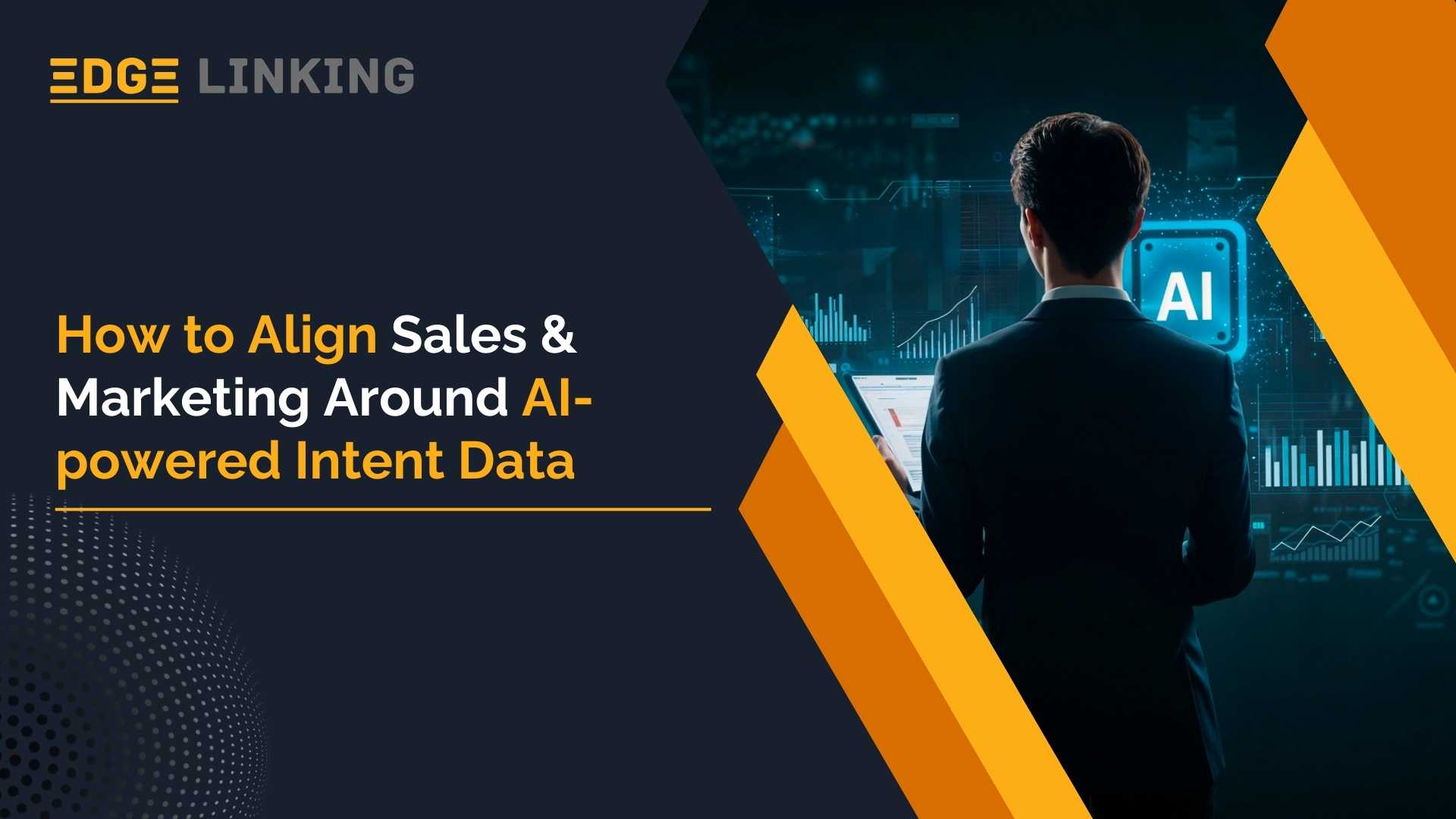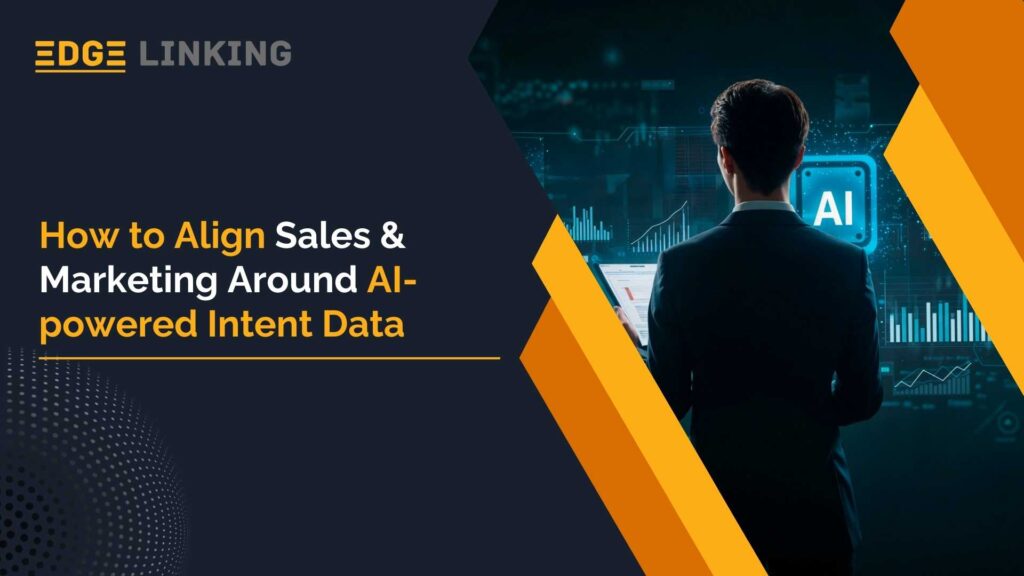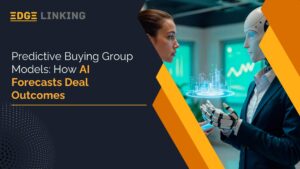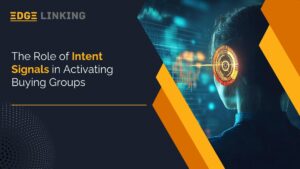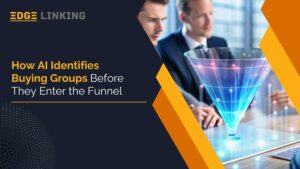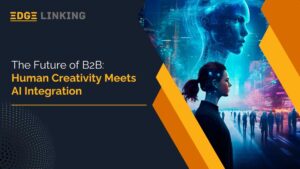Your sales team is reaching out to prospects who aren’t ready to buy, while your marketing team is running campaigns that don’t resonate with the right audience. The result? Missed opportunities, wasted resources, and misaligned vision. But if both teams work together, you can target prospects with the help of AI-powered intent data.
What makes AI-powered intent data so compelling? It can detect signals across content engagement, keyword searches, and social activity and turn them into insights. For marketing, it means crafting campaigns that speak directly to buyers. For sales, it means outreach to accounts armed with context on what prospects need.
This article will discuss the importance of aligning sales and marketing with AI intent data.
What Is AI-Powered Intent Data?
AI-powered intent data refers to the intelligence gathered through algorithms that analyze digital behaviors to determine likelihood of purchase. AI intent tracking signals include content consumption, keyword searches, website visits, and social interactions. Through intent data, you can identify the buyer, understand their active interests, and predict when they will get engaged.
AI intent bridges the gap between sales and marketing. Marketing teams can use it to craft campaigns, while sales teams leverage it to time their outreach. It ensures that organizations buyers messages are tailored to their stage in the decision journey accelerating deal velocity.
How AI-Powered Intent Data is Transforming the Alignment
Below are the keyways AI-powered intent data drives alignment.
1.Visibility into Buyer Behavior
AI intent uncovers what buyers are actively researching across the digital ecosystem. Both sales and marketing gain access to information, such as whether a prospect is exploring competitor solutions, consuming content, or searching for specific keywords.
Example: A cybersecurity firm integrated AI-powered intent data into their CRM, enabling both sales reps and marketers to see which accounts were researching “endpoint protection.”
2.Precision Targeting of Accounts
Instead of relying on static lead scoring, AI-powered insights highlight which accounts are “in-market” right now. Marketing can focus on ad spend and content promotion, while sales allocate resources to relevant opportunities.
Example: A SaaS provider used AI intent data to rank accounts by purchase readiness. The sales team focused on the top, showing the strongest buying signals.
3.Contextual Engagement
AI intent data uncovers the specific challenges a prospect care about. Marketing crafts messaging around those pain points, while sales use the same context in conversations.
Example: A HRTech company identified that several accounts were researching “AI in workforce management.” Marketing rolled out a thought-leadership campaign, while sales opened conversations around this.
4.Shorter Sales Cycles and Higher Conversion Rates
With both teams working from the same intelligence, the handoff becomes easy. Prospects are engaged with the right messaging, leading to reduced sales cycles.
Example: A cloud infrastructure company reported a decrease in average sales cycle after adopting AI-powered intent data.
5.Data-Driven Accountability
AI-powered platforms provide insights into campaign performance and buyer engagement, holding both teams accountable.
Example: A FinTech startup aligned KPIs across both teams using AI intent dashboards. Marketing measured success by pipeline contribution, while sales tracked conversion metrics.
The Role of AI in Identifying and Converting High-Intent Buyers
Below are the key roles AI plays in this transformation.
1.Early Detection of Buying Signals
AI scans content downloads, keyword searches, and social interactions to detect signs of purchase intent. It gives a head start in identifying opportunities.
Example: A SaaS company offering data analytics tools uses AI intent to spot enterprises researching “predictive analytics platforms.” By reaching out early with tailored demos, the company secured deals.
2.Contextual Intelligence for Personalization
Beyond identifying intent, AI reveals what prospects are interested in, such as specific solutions, pain points, or industry challenges. Marketing can tailor campaigns and sales can leverage the same context for outreach.
Example: A HRTech firm discovered via AI-powered signals that several accounts were researching “employee retention strategies.” Both teams launched campaigns tailored to the signals.
3.Acceleration of Sales Cycles
High-intent buyers are already in a problem-solving mindset. Engaging them with relevant messaging shortens the time from initial contact to closed deal.
Example: A cloud infrastructure company reported a reduction in sales cycle length after insights to focus on buyers actively exploring “hybrid cloud solutions.”
4.Continuous Optimization and Learning
Apart from identifying intent, AI learns from outcomes. It refines predictions and creates an optimizing system for identifying market shifts.
Example: A FinTech startup integrated AI-powered dashboards into its CRM. As the system learned, it refined its scoring model, boosting close rates.
Top Metrics You Should Track for AI Intent Data
Below are the top metrics every organization should track.
1.Intent Signal Volume
Measures the number of accounts showing engagement around relevant topics or keywords.
Example: A SaaS firm tracked monthly increases in AI intent signals for “cloud security.”
2.Account Engagement Score
Combines multiple data points into a weighted score for each account. It ensures these scores reflect actual purchase intent.
Example: A cybersecurity company used engagement scoring to rank accounts.
3.Pipeline Contribution from Accounts
Tracks how many opportunities in the pipeline originated from AI intent signals. Demonstrates the tangible impact of intent data.
A FinTech startup found that most of the pipeline was sourced from intent-driven campaigns, giving confidence in the investment.
4.Sales Cycle Length Reduction
Evaluates whether AI intent shortens the time from first contact to closed deal. Shorter cycles indicate better alignment between the teams.
Example: An IT services company reduced its average sales cycle by focusing only on accounts with strong AI-powered buying signals.
5.Marketing ROI on Intent-Driven Campaigns
Assesses the efficiency of marketing spend of accounts identified by AI intent data. Provides leadership with visibility of the budget investment.
Example: A SaaS provider reported that intent-driven LinkedIn campaigns yielded higher ROI compared to broad-based campaigns.
5.Win Rate of AI-Identified Accounts
Measures the percentage of deals closed among accounts by AI-powered data. Demonstrates the impact of intent data on business growth.
Example: A cloud infrastructure company increased its win rate by focusing on high-intent accounts identified through AI intent scoring.
Conclusion
Organizations that integrate intent data into their GTM strategy will build trust-driven relationships with their buyers. With the alignment of sales and marketing, it becomes a game-changer in this data-driven economy. Start the conversation today because the future of competitive advantage belongs to those who act on intent.
